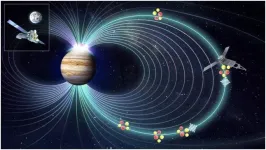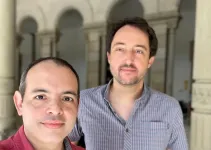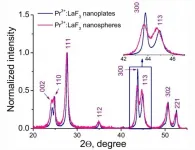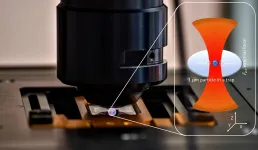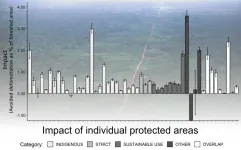Future information technologies: Topological materials for ultrafast spintronics
A team led by HZB physicist Dr. Jaime Sánchez-Barriga has gained new insights into the ultrafast response of topological states of matter to femtosecond laser excitation.
2021-07-16
(Press-News.org) The laws of quantum physics rule the microcosm. They determine, for example, how easily electrons move through a crystal and thus whether the material is a metal, a semiconductor or an insulator. Quantum physics may lead to exotic properties in certain materials: In so-called topological insulators, only the electrons that can occupy some specific quantum states are free to move like massless particles on the surface, while this mobility is completely absent for electrons in the bulk. What's more, the conduction electrons in the "skin" of the material are necessarily spin polarized, and form robust, metallic surface states that could be utilized as channels in which to drive pure spin currents on femtosecond time scales (1 fs= 10-15 s).
These properties open up exciting opportunities to develop new information technologies based on topological materials, such as ultrafast spintronics, by exploiting the spin of the electrons on their surfaces rather than the charge. In particular, optical excitation by femtosecond laser pulses in these materials represents a promising alternative to realize highly efficient, lossless transfer of spin information. Spintronic devices utilizing these properties have the potential of a superior performance, as they would allow to increase the speed of information transport up to frequencies a thousand times faster than in modern electronics.
However, many questions still need to be answered before spintronic devices can be developed. For example, the details of exactly how the bulk and surface electrons from a topological material respond to the external stimulus i.e., the laser pulse, and the degree of overlap in their collective behaviors on ultrashort time scales.
A team led by HZB physicist Dr. Jaime Sánchez-Barriga has now brought new insights into such mechanisms. The team, which has also established a Helmholtz-RSF Joint Research Group in collaboration with colleagues from Lomonosov State University, Moscow, examined single crystals of elemental antimony (Sb), previously suggested to be a topological material. "It is a good strategy to study interesting physics in a simple system, because that's where we can hope to understand the fundamental principles," Sánchez-Barriga explains. "The experimental verification of the topological property of this material required us to directly observe its electronic structure in a highly excited state with time, spin, energy and momentum resolutions, and in this way we accessed an unusual electron dynamics," adds Sánchez-Barriga.
The aim was to understand how fast excited electrons in the bulk and on the surface of Sb react to the external energy input, and to explore the mechanisms governing their response. "By controlling the time delay between the initial laser excitation and the second pulse that allows us to probe the electronic structure, we were able to build up a full time-resolved picture of how excited states leave and return to equilibrium on ultrafast time scales. The unique combination of time and spin-resolved capabilities also allowed us to directly probe the spin-polarization of excited states far out-of-equilibrium", says Dr. Oliver J. Clark.
The data show a "kink" structure in transiently occupied energy-momentum dispersion of surface states, which can be interpreted as an increase in effective electron mass. The authors were able to show that this mass enhancement plays a decisive role in determining the complex interplay in the dynamical behaviors of electrons from the bulk and the surface, also depending on their spin, following the ultrafast optical excitation.
"Our research reveals which essential properties of this class of materials are the key to systematically control the relevant time scales in which lossless spin-polarised currents could be generated and manipulated," explains Sánchez-Barriga. These are important steps on the way to spintronic devices which based on topological materials possess advanced functionalities for ultrafast information processing.
INFORMATION:
[Attachments] See images for this press release:
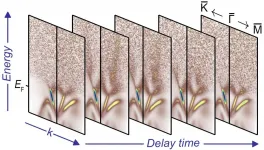
ELSE PRESS RELEASES FROM THIS DATE:
2021-07-16
An international research team led by YAO Zhonghua from the Institute of Geology and Geophysics of the Chinese Academy of Sciences (IGGCAS) has explained the cause of Jupiter's X-ray aurorae, a mystery that has puzzled scientists for 40 years.
The findings were published in Science Advances on July 9.
It is the first time planetary researchers have described the entire causality chain for Jupiter's X-ray auroral flares. The mechanism in producing X-ray auroral flares at Jupiter may have potential applications in X-ray astronomy.
The X-ray auroral spectra tell us these aurorae are produced by heavy ions with energies in the ...
2021-07-16
From the vocal cords that produce our voice, to our heartbeat, our body's cells are constantly subjected to mechanical forces that steadily change their response to these stimuli, regulating vital processes, in healthy individuals and in diseases such as cancer alike. Nevertheless, despite their importance, we remain largely ignorant of how cells sense and respond to these forces.
Now, an international team co-led by the researcher Pere Roca-Cusachs, from the Institute for Bioengineering of Catalonia (IBEC), and Isaac Almendros, a researcher at the Respiratory Diseases Networking Biomedical Research Centre (CIBERES) and IDIBAPS, both professors at the Faculty of Medicine and Health Sciences of the University of Barcelona (UB), has proved that what determines mechanical ...
2021-07-16
The article represents the transmission electron microscopy (TEM) and flow cytometry study of A-549 (human lung carcinoma) cellular uptake of Pr3+:LaF3 nanoparticles. The Pr3+:LaF3 nanoparticles are promising platforms for cell nano-sensors.
The objective of the work was to study the influence of nanoparticle morphology (nanoplates and nanospheres) on cytotoxicity and the dynamic of cellular uptake.
In the flow cytometry method, the cells go through a small tube (as a flow) and are irradiated by a laser. Cells scatter the laser light, and this scattering ...
2021-07-16
Measurements of biomechanical properties inside living cells require minimally invasive methods. Optical tweezers are particularly attractive as a tool. It uses the momentum of light to trap and manipulate micro- or nanoscale particles. A team of researchers led by Prof. Dr. Cornelia Denz from the University of Münster (Germany) has now developed a simplified method to perform the necessary calibration of the optical tweezers in the system under investigation. Scientists from the University of Pavia in Italy were also involved. The results of the study have been published in the journal Scientific Reports.
The calibration ensures that measurements of different samples and with different devices are comparable. ...
2021-07-16
The ability to predict and interpret modifications of ribonucleic acid (RNA) has been a welcome advance in biochemistry research.
However, existing predictive approaches have a key drawback--they can only predict a single type of RNA modification without supporting multiple types or providing insightful interpretation of their prediction results.
Researchers from Xi'an Jiaotong-Liverpool University, led by Dr Jia Meng, have addressed this issue by developing a model that supports 12 RNA modification types, greatly expanding RNA research prediction and interpretation.
"To the best of our knowledge, ...
2021-07-16
While tropical forests remain threatened and their future is uncertain, the importance of understanding how well individual protected areas avoid deforestation increases. Researchers from the University of Turku and University of Helsinki, Finland, have investigated this question in a newly published study that focuses on the State of Acre in Brazilian Amazonia.
Tropical forests are unique environments that have huge species diversity and also act as important reservoirs of organic carbon, thereby counteracting climate change. However, their area is diminishing due to deforestation, ...
2021-07-16
Tsukuba, Japan - A team of scientists led by Associate Professor Haruka Ozaki of the Center for Artificial Intelligence Research at the University of Tsukuba in collaboration with Dr. Koichi Takahashi from RIKEN used mathematical algorithms to optimize the schedule of automated biology laboratory robots. By analyzing the needs of time-sensitive samples that require investigation using multiple instruments, the researchers were able to maximize the number of experiments that can be performed within time and laboratory resource constraints. This work may help in the design of future automated biology labs and other workspaces.
Biology laboratories have seen increasing automation because many tasks, like pipetting solutions or moving cells from one ...
2021-07-16
CAMBRIDGE, MA -- Most of the tests that doctors use to diagnose cancer -- such as mammography, colonoscopy, and CT scans -- are based on imaging. More recently, researchers have also developed molecular diagnostics that can detect specific cancer-associated molecules that circulate in bodily fluids like blood or urine.
MIT engineers have now created a new diagnostic nanoparticle that combines both of these features: It can reveal the presence of cancerous proteins through a urine test, and it functions as an imaging agent, pinpointing the tumor location. In principle, this diagnostic could be used to detect cancer anywhere in the body, including tumors that have metastasized from their original locations.
"This is a really broad sensor intended to respond to both primary tumors and their ...
2021-07-16
Reno, Nev. (July 15, 2021) - Wildfire smoke may greatly increase susceptibility to SARS-CoV-2, the virus that causes COVID-19, according to new research from the Center for Genomic Medicine at the Desert Research Institute (DRI), Washoe County Health District (WCHD), and Renown Health (Renown) in Reno, Nev.
In a study published earlier this week in the Journal of Exposure Science and Environmental Epidemiology, the DRI-led research team set out to examine whether smoke from 2020 wildfires in the Western U.S. was associated with an increase in SARS-CoV-2 infections in Reno.
To ...
2021-07-16
A new study by Vanderbilt University Medical Center researchers of more the 400,000 Medicare patients taking medications for insomnia found that the risk of death is increased when either benzodiazepines or "z-drugs" are taken with opioids.
The study, published July 15 in PLOS Medicine and led by Wayne Ray, PhD, professor of Health Policy at VUMC, compared patients taking these drugs with opioids to comparable patients taking trazodone, another commonly prescribed sleep medication for older patients.
The researchers found that those using benzodiazepines had a 221% increase in the risk of death from ...
LAST 30 PRESS RELEASES:
[Press-News.org] Future information technologies: Topological materials for ultrafast spintronics
A team led by HZB physicist Dr. Jaime Sánchez-Barriga has gained new insights into the ultrafast response of topological states of matter to femtosecond laser excitation.

